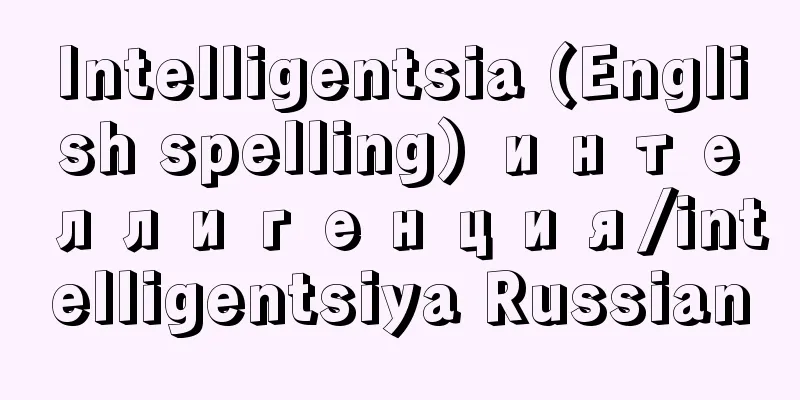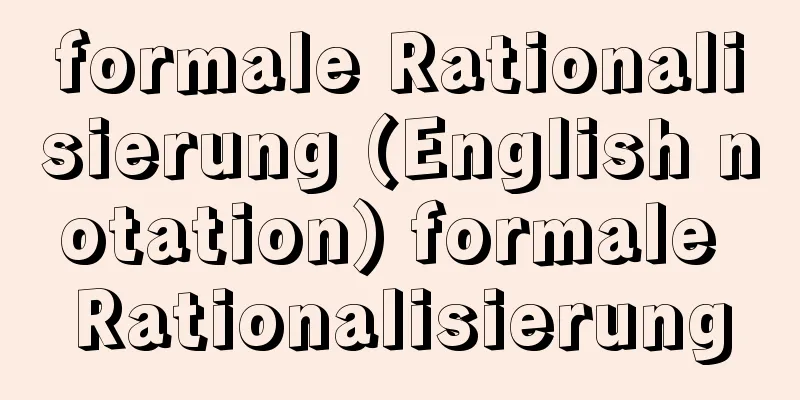Intelligentsia (English spelling) интеллигенция/intelligentsiya Russian

|
It is usually translated as "the intellectual class." In this case, "class" does not mean the "class" used in Marxism. Strictly speaking, it is more a "stratum," but since the term "intellectual class" is not familiar, it is usually referred to as the "intellectual class." The origin of the word intelligentsia comes from the Latin word intelligens, which means "one with understanding." Also, since the word intelligentsia is Russian, it can be seen that the intellectual class was first established in Russia. Words commonly used that are synonymous or similar to the intellectual class include "intellectuals," "intellectuals," and "cultural people." [Suzuki Yukitoshi] Establishment and historyHistorically, social classes that lived as intellectual or mental workers include, for example, the literate class appointed through the Chinese imperial examination system, and administrative officials and scholars who served feudal lords. However, the intellectual class was directly established in the middle of the 19th century, during the imperial Russia. That is, in a class-based society of aristocrats, commoners, and serfs, some intellectuals who were interested in the miserable lives of the oppressed serfs set the goal of abolishing the class system through social reform, and sought to become, so to speak, intellectual carriers of criticism of the old system, which made the existence of the intelligentsia clear. This intelligentsia group was made up of a diverse range of people, including doctors, writers, aristocrats, and students. However, among them, there were groups that simply criticized the system and groups that went as far as to criticize it through practical activities. It cannot be denied that the intelligentsia's passive and active criticism of the system was one step on the way to the Russian Revolution (1917). It should be said that the intelligentsia only made a full-scale appearance after the establishment of capitalist society and the modern nation-state. In order to carry out production under the capitalist mode of production and to run a unified nation-state, it is necessary to organize what is called an industrial bureaucracy or bureaucratic organization. Furthermore, in order to make it function effectively, it is necessary to have many experts and knowledge holders. These experts and knowledge holders were mainly cultivated in technical schools and universities. Modern nations, while completing their compulsory education systems, also established higher education institutions to cultivate an intellectual class, which gave birth to many teachers, government officials, engineers, researchers, scholars, and so on, who came to establish their raison d'être as a social class engaged in intellectual work. As modern society has moved to the contemporary era, the national and social demand for intellectual labor has increased in both developed and developing countries. This is not unrelated to the rapid progress of science, but also closely related to the progress of rationalization, also known as Westernization. The number of skilled, semi-skilled, and unskilled manual laborers has gradually decreased, and the number of people who can respond to technological innovation has been replenished by those who have completed higher education. This period continued for a fairly long time, but after World War II, as universities in developed countries became more popular, the absolute number of so-called "graduates" has increased. As universities have become more popular, not only has the "eliteness" that the intellectual class once possessed gradually been lost, but even the uniqueness of the intellectual class has diminished in significance. The quantitative expansion of the intellectual class has been raised as a question of the role and function that it should play. [Suzuki Yukitoshi] Types and PersonalitiesWhen considering the type of social existence of the intellectual class in relation to the performance of the functions given to them, there are the following four types, and accordingly, four characteristics can be given to each type: (1) those who are close to authority, (2) those who are detached from authority and the people, (3) those who are anti-authority and close to the people, and (4) those who are anti-authority and detached from the people. (1) is completely close to authority, as seen in the examples of high-ranking government bureaucrats, senior executives of companies, some executives of the mass media, and some university professors, and therefore their intellect is strongly conservative and they represent an important position that plays a role in maintaining the system. (2) does not participate in authority, does not have close contact with the people, and is, so to speak, an isolated existence. Some of them have a petty bourgeois consciousness and use their intellectual abilities as a means to advance in their careers, and others are reclusive types who are absorbed in limited affairs and skills and do not take an active stance to get involved with the people. (3) is a type that tries to resist authority from beginning to end, and does not give up on the attitude of fighting together with the people. In the past, this type was often seen among those who actively committed themselves to social movements and labor movements, but recently it is also seen in leaders of mass movements. Since they fight together with the masses, they always have to play a leadership role and sometimes have to become instigators. Also, if the masses become detached from them or they are forced to abandon the masses, they often feel frustrated and go back to type (2). (4) is anti-authority, but is not a type that tries to burn its energy together with the people. It is a lone wolf, so to speak. This type is generally seen in radical liberals, but if they are detached from the masses, no matter how much they try to resist authority alone, they will ultimately end up compromising (failure, conversion) or losing. Among the scholars who developed the theory of the intellectual class, Karl Mannheim highly values people belonging to the type (2), and believes that the intellectual class is supra-class neutral, and therefore is the class that can make the most reasonable judgments even in the midst of class conflict ("the free-flying intelligentsia"). Theodor Geiger divides the intellectual class into three categories: academics, educated people, and the true intelligentsia, with academics being people who have received specialized technical education, such as engineers and office workers. Educated people are people who have absorbed the culture of an era to the fullest extent and have acquired a harmonious mental attitude, and he cites Leonardo da Vinci as a representative example. In addition to these two, Geiger calls those with a high ability to create culture or develop it creatively the true intelligentsia. Robert Merton, who is discussing intellectuals rather than the intellectual class, defines intellectuals as those who are absorbed in cultivating and formulating knowledge. Therefore, teachers and professors who simply convey the contents of textbooks are not intellectuals at all, but merely announcers who read scripts prepared by others. Rather, he calls those who work as experts in the fields of social, economic, and political knowledge true intellectuals. Specifically, he sees social scientists and lawyers as representatives, but in this case, he further divides them into two groups: intellectuals who play the role of advisors or technicians in bureaucratic organizations (intellectuals who participate in policy-making) and intellectuals who do not belong to the bureaucracy (intellectuals who are with the people). The former fall into type (1), and the latter mostly fall into type (3). [Suzuki Yukitoshi] Japan's Intellectual ClassIn Japan, people belonging to types (3) and (4) appeared as critics of the old system and anti-authority resistance at the end of the Tokugawa Shogunate period, but they were unable to muster the energy for change in the face of the Meiji government's absolutist modernizing forces. An intellectual class that made a living through intellectual work was cultivated as the human resources needed to promote the Meiji government's policies of "civilization and enlightenment" and "enriching the country and strengthening the military," and most of them became government bureaucrats or worked in the industrial bourgeoisie to maintain the system. On the other hand, some intellectuals took an anti-government (anti-authority) stance as promoters of the Freedom and People's Rights Movement, but they were defeated by conservative forces and had to remain ideologues of civil liberalism. With the development of capitalism in Japan, the class conflict between the proletariat and the bourgeoisie became more acute, and the intellectual class also became polarized into two camps, one on the side of the bourgeoisie and the other on the side of the proletariat. However, this polarization gave rise to intellectual classes that can be categorized as types (2) to (4). Some intellectuals who fell into the proletariat sought refuge in intellectualism, which was isolated from politics, and became completely cynics. Intellectuals of type (4) suffered defeat and setbacks in their attempts to resist the approaching militarism on their own, but many bystander intellectuals were plagued by a sense of powerlessness and, not knowing what to do, fell into self-loathing. As the trend towards fascism progressed, Maruyama Masao has named small factory owners, retail store owners, school teachers, lower-ranking bureaucrats, clergy, and priests who worked closely with the ruling class at the top and became the social carriers of fascism at the grassroots level as "pseudo-intellectuals." However, it can be said that the true intellectual class, with the exception of those who supported the maintenance of the system, was placed in a suffocating situation. After the Second World War, freedom of speech and thought was restored, and an increasing number of intellectuals assumed an avant-garde role for democratization and actively committed themselves to the labor movement and mass movements, but on the other hand, there were also those who accepted the existence of a "free-flying intelligentsia" or those who protested in isolation as anti-authority figures. However, in the case of Japan, the intellectual class has expanded rapidly as part of the phenomenon of mass socialization, and as a result, the reason for its existence and its function are becoming extremely ambiguous. This has been particularly accelerated by the extraordinary development of the information industry that has accompanied the information society. The increase in the number of people involved in the so-called mass media has raised questions about the evaluation of their intellectual function as intellectuals. There are intellectuals who are cultural creators and intellectuals who simply disseminate and communicate information, and the question is what role the latter will play in cultural creation in the future. [Suzuki Yukitoshi] "Ideology and Utopia" by K. Mannheim, translated by Suzuki Jiro (1954, Kawade Shobo)" ▽ "The Intellectual Class" by T. Geiger, translated by Suzuki Yukitoshi (1953, Genkai Publishing)" ▽ "The Thoughts of Japanese Intellectuals" by Matsuda Michio (1965, Chikuma Shobo) ▽ "The Intellectual Class Theory" by Mukaizaka Itsuro (1935, Kaizosha)" ▽ "F. Znaniecki The Social Role of the Man of Knowledge (1940, Columbia Univ. Press, NY, USA)" ▽ "L. Coser Men of Ideas (1965, The Macmillan Co. & The Free Press, NY, USA)" Source: Shogakukan Encyclopedia Nipponica About Encyclopedia Nipponica Information | Legend |
|
普通「知識階級」と訳される。この場合の「階級」とは、マルクス主義で用いているような「階級」の意味ではない。むしろ厳密にいえば「階層」にあたるが、「知識階層」という名称はなじみが薄いので、通常「知識階級」といっているにすぎない。インテリゲンチャということばの語源は、「理解力のある人」を意味するラテン語のintelligensに由来する。またインテリゲンチャということばは、ロシア語であるから、最初はロシアにおいて知識階級が成立したとみることができる。なお、知識階級と同義的ないし類義的なことばとして一般に用いられているものに「知識人」「インテリ」「文化人」などがある。 [鈴木幸寿] 成立とその歴史知的ないし精神的労働者として生活してきた社会的階層には、歴史的にみれば、たとえば中国の科挙制度によって登用された読書人階級や封建領主に仕えた行政官や学者などが含まれる。ただ、知識階級の成立は、直接的には19世紀の帝政ロシア中期である。すなわち、当時、貴族、平民、農奴といった身分制社会において、虐げられていた農奴の悲惨な生活に関心をもった一部の知識層が、社会改革による身分制の撤廃を目標に掲げ、いわば旧体制批判の知的担い手たらんとしたことがインテリゲンチャの存在を明確にした。このインテリゲンチャ集団は、医師、作家、貴族、学生など多彩な人々から構成されていた。しかし彼らのなかにも、体制を単に批判するだけのグループと、実践活動まで行って批判するグループとがあった。こうしたインテリゲンチャの消極的、積極的な体制批判の動きは、ロシア革命(1917)への一つの道程となったことは否定できない。 インテリゲンチャが本格的に出現したのは、資本主義社会や近代国民国家の成立をまってからのことであるとみるべきである。資本主義的生産様式による生産を行い、また統一的国民国家を運営していくためには、いわゆる産業官僚制的ないし官僚制的組織を整えなければならない。さらに、それらを有効に機能させていくためには、多くの専門家や知識所有者を擁しなければならない。これら専門家や知識所有者の育成は、主として専門学校や大学において行われた。近代国家は、義務教育制度を完備しながら、さらに高等教育機関を設置して、知識層の育成を図ったため、多くの教師、官吏、技術者、研究者、学者などが生まれ、彼らはまさに知的な労働に従事する社会層としての存在意義を確立するに至ったのである。 近代社会から現代社会へと移行するにつれて、先進諸国においても発展途上国にあっても、知的労働に従事する人材への国家的、社会的需要が増大した。このことは、科学の飛躍的進歩と無縁ではないし、また西欧化といわれる合理化の進展とも密接にかかわっている。かつての熟練・半熟練・未熟練といった肉体労働者がしだいに減少し、技術革新に即応する人材が高等教育終了者によって補充されることになった。こうした時期はかなり長期間にわたって続いたが、第二次世界大戦後、先進国における大学の大衆化が進展するにつれて、いわゆる「学卒者」の絶対数が増加してきた。このように大学の大衆化現象が進行すると、かつて知識階級が有していた「エリート性」は徐々に失われるばかりか、知識階級の独自性すらその意義を減ずるに至る。知識階級の量的拡大は、その果たすべき役割とか機能をめぐる問題として提起されている。 [鈴木幸寿] 類型と性格知識階級に与えられた機能の遂行との関連で、彼らがどのような社会的存在であるかを考える場合、次の四つの類型があり、それに伴って、それぞれ四つの性格づけができる。(1)権力密着型、(2)権力・民衆遊離型、(3)反権力・民衆密着型、(4)反権力・民衆遊離型である。(1)は政府の高級官僚、企業の上級幹部、一部のマス・メディア幹部、あるいは一部の大学教授などの例にみられるように、完全に権力に密着しており、したがって彼らの知性は保守性が強く、体制維持的役割を果たす重要な立場を代表している。(2)は権力に参加せず、また民衆とも密着せず、いわば孤立した存在である。彼らの一部には小市民的意識をもちつつ自己の知的能力を立身出世の手段として利用する者、また限定された事務や技術に没頭し、積極的に民衆のなかに入っていこうとする姿勢をとらない隠遁(いんとん)型といってもよい者がある。(3)は権力に徹頭徹尾抵抗しようとし、自らはまた民衆のなかに入ってともに闘う姿勢を崩そうとしないタイプである。このタイプはこれまで、社会運動や労働運動に積極的にコミットした者のなかに多くみられるが、最近は大衆運動のリーダーなどにもみられる。彼らは大衆とともに闘うということから、つねにリーダー的役割を果たさなければならず、ときに扇動者ともならざるをえない。また、大衆がひとたび彼らから遊離したり、彼らが大衆を見放さざるをえない状況に立ち至った場合は、挫折(ざせつ)感を覚え、(2)のタイプに戻っていくことが多い。(4)は反権力的だが、そのエネルギーを民衆とともに燃焼させようとするのではないタイプである。いわば一匹狼(おおかみ)的存在である。一般的には急進的リベラリストなどにみられるタイプだが、しょせん大衆から遊離している場合、いかに権力に単身抵抗を試みても、最終的には妥協(挫折、転向)か敗北に終わってしまう。 知識階級論を展開した学者のなかで、カール・マンハイムは、(2)の類型に属する人々を高く評価し、知識階級が超階級的中立的な、したがって階級的対立のなかにあっても、もっとも妥当な判断をもちうる階層であると考えている(「自由に飛翔(ひしょう)するインテリゲンチャ」)。またテオドール・ガイガーは、知識階級を、アカデミカー、教養人、そして本来のインテリゲンチャに三分し、アカデミカーは専門技術教育を受けた者で、たとえば技師、事務サラリーマンなどをその代表にあげている。教養人は、一時代の文化をあますところなく自己のなかに吸収して、調和的な精神態度を獲得した者とし、その代表として、たとえばレオナルド・ダ・ビンチをあげている。ガイガーの場合、この両者とは別に、文化を創造し、あるいは創造的に発展させうる高い能力をもつ者を本来のインテリゲンチャと名づけている。ロバート・マートンは知識階級というより知識人を論じているが、知識人を、知識の培養と定式化に没頭している者と規定している。したがって、単に教科書の内容を伝えるだけの教師や教授は、けっして知識人ではなく、他人が用意した原稿をただ読むだけのアナウンサーにすぎないとし、むしろ社会的、経済的、政治的知識の領域で専門家として仕事をしている人々を本来の知識人といっている。具体的には、社会科学者と法律家をその代表とみているが、この場合さらに、ビューロクラシー機構のなかで顧問や技術者の機能を果たしている知識人(政策決定に参与する知識人)と、ビューロクラシーに所属しない知識人(民衆とともにある知識人)とに2大別している。前者は類型では(1)に該当し、後者はほぼ(3)に入る。 [鈴木幸寿] 日本の知識階級日本ではすでに幕末期に(3)や(4)の類型に属する者が旧体制批判者や反権力抵抗者として出現したが、明治政府の絶対主義的近代化の力との対決で変革のエネルギーを結集できなかった。明治政府の「文明開化」「富国強兵」の政策推進のために必要な人材として、知的労働を生活手段とする知識階級が養成され、そのほとんどは体制維持のための政府官僚あるいは産業ブルジョアジーとして活躍した。しかし他方において、自由民権運動の推進者として反政府的(反権力)立場にたつ一部の知識階級も輩出をみたが、彼らは保守勢力の前に敗北し、市民的自由主義のイデオローグにとどまらざるをえなかった。 日本における資本主義の発展に伴い、プロレタリアートとブルジョアジーの階級対立が先鋭化し、知識階級もブルジョアジー側とプロレタリアート側にたつ二つに分極化した。しかしこの二極化からさらに、類型的には(2)ないし(4)に属する知識階級が派生している。プロレタリアートに転落しながら、政治と絶縁された教養主義に逃避の場を求め、シニシズムに徹する者もいた。(4)の型の知識人は、迫りくる軍国主義に単身抵抗を試みつつ敗北と挫折に陥ったが、傍観者的知識人は無力感にさいなまれ、なすすべを知らず自己嫌悪に陥った者も多い。ファシズム化がますます進行するなかで、トップにたつ支配層と密着して末端においてファシズムの社会的担い手になった町工場主、小売店主、学校教員、下級官僚、僧職、神官などを、丸山真男(まさお)は「擬似インテリゲンチャ」と名づけているが、本来的知識階級は、ほぼ体制維持派を除けば、閉塞(へいそく)的状況に置かれたといってよい。 第二次世界大戦後、言論・思想の自由が回復されるとともに、民主化のための前衛的役割を自らに課し、労働運動、大衆運動に積極的にコミットする知識階級も続出したが、他方では「自由に飛翔するインテリゲンチャ」的存在に身をゆだねる者、あるいは孤立的に反権力者として異議申立てを行う者などが存在している。しかし日本の場合、大衆社会化現象の一環として、知識階級の急速な拡大がみられ、そのため、知識階級の存在理由とその機能とはきわめてあいまいになりつつある。 とくにこれに拍車をかけたのは、情報化社会に伴う情報産業の異常な発達である。いわゆるマスコミ関係者の数的増加が、彼らの知識人としての知的機能の評価に問題を投げかけている。彼らには文化創造者としての知識人と、単なる普及者、伝達者としての知識人とがあり、後者が今後文化創造上いかなる役割を果たすかが問われている。 [鈴木幸寿] 『K・マンハイム著、鈴木二郎訳『イデオロギーとユートピア』(1954・河出書房)』▽『T・ガイガー著、鈴木幸寿訳『知識階級』(1953・玄海出版社)』▽『松田道雄著『日本知識人の思想』(1965・筑摩書房)』▽『向坂逸郎著『知識階級論』(1935・改造社)』▽『F. ZnanieckiThe Social Role of the Man of Knowledge (1940, Columbia Univ. Press, N.Y., USA)』▽『L. CoserMen of Ideas (1965, The Macmillan Co. & The Free Press, N.Y., USA)』 出典 小学館 日本大百科全書(ニッポニカ)日本大百科全書(ニッポニカ)について 情報 | 凡例 |
Recommend
Soldati, A. (English spelling) SoldatiA
...But what is most important is that they remove...
Leclerc, D. (English spelling) LeclercD
…For example, the pioneering work of J. Priestley...
Certificate - Shoban
A term used in paleography. It refers to the words...
Aiga-so - Ouga no Sho
This manor was located in Ito County, Kii Province...
Erasmus - Desiderius Erasmus
Dutch humanist. Born in Rotterdam as the illegiti...
Ganser's syndrome
Ganser is also known as a daze. It is a hysterical...
Aluminum Paint
Aluminium paint is a silver enamel made with powde...
Dai-nyūdō - O-nyūdō
〘noun〙① A big monk. Daibozu . ② A big man with a s...
Value scale - Kachishakudo
… [Economics of Money] [Definition and Function o...
Emperor Gosaga
Born: February 26, 1220, Kyoto [Died] February 17,...
Koizumi Sakutaro - Koizumi Sakutaro
A journalist and politician from the late Meiji t...
Agave potatorum (English spelling) Agavepotatorum
… [Takabayashi Masatoshi]. … *Some of the termino...
Olfactory vesicle
…The diameter of the cell body containing the nuc...
Feng Yi
The name of the river god. Fui. Fuui. ※Seigen-in T...
Quincy Jones - Quincy Jones
...Saxon and others began to incorporate electric...









